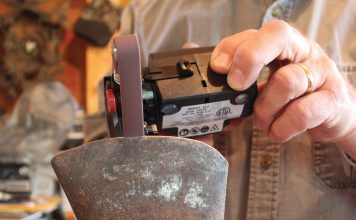 |
|
| Issue #106 • July/August, 2006 |
There’s something very visceral about having your own piece of land, whether it’s a little scrap of green terrace or a vast expanse of fertile bottomland. Ownership (or rentership) of ground tugs at a series of primal instincts to cultivate, to promote growth, to improve, and ultimately to enjoy the rewards of your efforts. Urban dwellers satisfy this drive by planting flowers in window boxes and herbs in pots on apartment ledges. Suburbanites lavish attention and money on carpet-thick lawns and sculpted terraces. Rural denizens concentrate their efforts on a particular field or specific livestock. Yet, in each case, there is always an ultimate goal, to manage the soil and land to achieve some direct benefit.
Now, this is a good thing. The discovery that good land management returns a financial and emotional reward tends to promote better management in the future, which is also a good thing! The challenge, of course, is figuring out the thing that will bring the best return, using the abilities and skills you already have, and fitting your efforts into the time you have available. Sometimes, that combination of parameters creates a daunting barrier to further action: I’ve only got a backyard lawn, and a little time on weekends; how can I possibly earn any income off of that?
|
To answer that, I can share my experience. When we lived in Los Angeles in a miniscule city home, our entire lot was 40 feet wide and 70 feet long. (Later, when we lived on a farm, our garden was bigger than that!) In that space, a small house, garage, concrete patio, and grassy yard all seemed too tiny to squeeze in anything that might have contributed to making an additional income, but somehow, we managed. We grew grapes up a chicken-wire lattice on the south side of the house, and planted highly productive dwarf fruit trees and harvested dozens of pounds of peaches, apples, and apricots every year. Not only was the flavor better than store-bought, by growing our own we avoiding having to spend money on fruit. We created a tiered 4’x4′ strawberry “patch” that provided luscious berries all year around. Our front chain link fence provided a trellis for chayote vines, which routinely gave over 100 pounds of “squash” yearly.
At one point, we housed over 60 breeding rabbits, stacked like apartment dwellers in homemade cages three “stories” high. Those bunnies racked up around $7200 net annually, sold to pet shops and private individuals plus provided a significant protein complement to our diet and some of the finest fertilizer available for our garden and our friends’ gardens as well. A tall, narrow, multi-level cage housed over 100 Coturnix quail, fast reproducing and mini-egg laying wonders. We sold eggs and chicks, plus had all the “gourmet” eggs we could eat. The concrete patio provided an area for hubby Nick to teach fencing (the sword kind), and an old upright piano in the small living room provided a place for me to give piano lessons. And, of course, both Nick and I wrote and sold freelance non-fiction articles by sharing time on an IBM Selectric typewriter. We both were at home all day, so our children were home-schooled, too. Remember, this was on a lot smaller than a country garden. If we could do it, so can you!
A personalized plan
Earning a profit from your land, honestly, won’t be instantaneous and will require effort. As a quick refresher, consider this: there are only three main things that you can sell. I’m going to emphasize these, because any one or combination of these can be the basis for your own plan-for-profit off your land:
- Products: items you make, build, improve, develop, grow, or produce to provide a good that buyers need or want.
- Skills: what you can do, teach, explain, or accomplish that provides knowledge or new abilities that people need or want.
- Services: actions you can carry out to serve the needs or wants of other people. Some services are simple manual tasks that potential buyers just don’t want to do or can’t do on their own (say, cleaning windows or carpets, or locating a special part for an old sewing machine). Others require more complex skills, combining skill and service in one swoop (such as: auto repair, computer debugging, or designing a landscape).
|
Every step in the process of building your profit system can also be rewarding and satisfying in its own way. Keep in mind that each of the following planning steps takes you closer and closer to your goal.
1. Know your land. This is both simpler and more complex than it sounds. I suggest you draw a map of your available ground, even if it’s only a small patio space next to a condo. Get some graph paper or a piece of poster board. Spend several days to a week or so examining and measuring out your available space and draw out your property outlines. Include buildings, concrete areas, trees, reserved areas (kid’s play zone, for example), as it currently exists. Remember to look up as well as down; notice building heights, trellises and overhangs, and where sunlight falls. This will be your basic tool for the rest of your progress, so make this detailed enough that you can close your eyes and visualize the layout readily. Imagine where you could tuck in small cages, planters, or tools.
2. Write out your skills. Again, simpler and more complex than it appears. Those abilities you take for granted (say, changing the oil on your car, playing clarinet, training dogs, identifying garden herbs, baking bread from scratch, typing 70 words per minute, and so forth) are NOT free goods. Each skill took you time and effort to acquire, and your time and existing skills all have value. Part of earning money on your land includes accepting the reality that you are allowed to profit from what you know. Don’t stop listing your skills until you have at least 15 on your list. Most people can list over 40 skills if they think about it for a while. It helps, also, to consider how much you’d have to pay someone else to do the particular action, too. It might seem easy to replace your house’s plastic water pipes, but if you had to hire a plumber to do the same work you’d realize how valuable that skill is.
3. Write down specific benefits of your area. This step can be the trigger to developing your plan, observing and acknowledging those features of your region that promote business development. Take a walk around the area or the neighborhood, notice what kind of businesses already flourish there. Observe the income level (up-scale, moderate, downscale), and what people seem to want. If you supply something people want, you’ll be able to sell whatever you produce. Don’t try to duplicate existing businessescreate something better, cheaper, or easier to acquire. Keep in mind that some elements that might be uncomfortable in other settings, such as high population density, can be a plus: more potential customers are available.
4. Write down specific limitations of your area. Weather is often a limiting factor in developing income plans you can’t grow fruit outdoors in a Maine winter, for example. If you live an hour’s drive from the nearest town, that will limit access from potential buyers. If you live in a gated community, it will be challenging for potential buyers to meet you spontaneously. This step helps you keep a realistic attitude about your plans.
|
5. Write down how you want to live in one year, two years, five years. Our goal was to work at home, to make the land we lived on a place of profit as well as a place to sleep truly, a “homestead.” We wanted to raise our children in a safe environment and produce the majority of our own food. Our plan was to acquire a two story house, paid off, in a rural setting that was both productive and pretty and that’s where we landed only four short years after we began working toward that goal. We were not interested in having a huge income, or in amassing IRAs, but you might be. Remember to factor your real (as opposed to desired) income needs in when you set up your plans.
You’ll spend a good week or longer sorting out these five steps, but this information will be the foundation for the money-making ideas in the next section.
10 ways to make $$$
The following are meant as introductory concepts, designed to get you thinking. Let each act as a brainstorm-starter-hold an idea in mind, and imagine its ramifications in your setting, on your land. Be sure to write down key points; keep a notebook handy. Don’t let a good idea get away because you forgot to write it down.
1. Teach. This can be done in city or country. Look back at your list of skills. What can you do? Play a musical instrument? Ride a horse well? Sing? Dance? Gourmet cooking? Tai chi? Make pottery? Wildcraft herbs? Weave or spin wool? Build a masonry wall? Paint? Karate? Do reflexology massage? Someone in your area wants to learn what you know. In order to teach, you need students. In order to get students, you must advertise locally: word of mouth, posters at local colleges and markets, sharp-looking business cards (make them on your computer), and perhaps a magnetic sign on the doors of your vehicle if your transportation is neat and clean. Put your ads where people likely to want your knowledge might go, such as health food stores, veterinary supply houses, or book stores. Offer a 500-word how-to article about your area of expertise (“How to grow a great tomato,” “How to find a deal on a used car”) to your hometown newspaper. Local newspapers often carry short informative pieces by local folk. People will consider you an expert after they see it.
Don’t spend much for your initial advertising start small and let the business begin to pay its own way. Check out the prices of your competition, and underprice them just a little for your first experiences later, as your client base increases, you can raise your price to middle range or higher. Decide in advance what a “course” will be; 4 weekly meetings for beginners? A 3-hour group meeting on one Saturday morning? Provide a clear, written description of what you teach and what the student can expect from a course. Anticipate what equipment you and your students will require; extra tools for beginners, clean-up supplies, blackboards or computer access. Keep notes on what you did and if it worked, and change how or what you teach to accommodate what you learn about students. Teach the course you wish you had been able to take. Remember, you’ll lose a percentage of studentsit’s not what they expected, too much work, they find another interest don’t take it personally. Give them more than they expect, and keep learning.
2. Raise small stock: We kept rabbits in the city and made a profit. What do people buy in your area? Is it an animal you’d like to raise? How about parakeets, finches, or cockatiels small space requirements with potential sales to pet shops? Rats are interesting pets, smart, and breed rapidly. Exotic colors or hairless rats, which reproduce just as well as white ones, sell for higher rates. Guinea pigs and hamsters remain popular (though low-profit) pets. Dogs and cats are perennial sellers. Keeping a pair of cats or small dogs in a city or country residence requires no more effort than keeping a single one. They can produce 1-2 litters per year, of 4-6 offspring each time. Aim to produce healthy animals in desired breeds and colors. Smaller dogs cost less to feed than big ones, and sell more readily. Read extensively about dog or cat breeding. If you haven’t kept un-neutered animals beforethey behave differently than fixed ones, and breeding may require specialized skills or equipment.
Acquire good quality registered breeding stock, from unrelated healthy lines. Avoid “show winners” since they are bred more for looks than for health or personality. Watch out for fad animals, though iguanas, hedgehogs, pot-bellied pigs, emus, monkeys they go through phases of public interest and price fluctuations that make Wall Street look tame. Remember, if you consider breeding small stock, that there will be veterinary costs, vaccinations, registration costs, feed requirements, and cages plus cleaning, handling, walking, and daily care. Healthy, clean, vibrant animals command the highest prices, too. If you like the small stock you raise, it won’t be a chore. I would caution you not to sell to pet brokers, however, both because you can’t control how your infants are handled by the broker, and because your profit will be much smaller than selling directly to the new owners. Check out the “pets for sale” in your local newspaper for an idea of the profit potential, and what people are buying locally.
|
3. Hospitality/retreat: If you have several acres of land and an attractive rural location (no matter how far out), consider offering a retreat or holiday getaway spot. Typically, customers for this service are upscale or middle-upper folk, who just want to get away from their usual life into a facsimile of country or wilderness living for a time. “Facsimile” is the key word here. Most often, these clients don’t want the discomforts of rural living flies, odors, power outages, or exposure to real weather. They want to see cows and horses, perhaps pet a goat, and hold an egg minutes after it came from the chicken. They will require phone, electric, internet (wi-fi), air-conditioning, and thermostat-controlled winter heating. This customer base will pay a premium for the country experience, and $750 to $1500 per week is not unrealistic. Keep in mind that these will be high-input clients, who expect to have their whims catered to. The return may make it worthwhile for you.
Alternatively, consider appealing to the back-to-nature person, who just wants a little rough cabin on a hillside, a clean-burning oil lamp, and silence (with daily organic food deliveries to their door, of course). This individual or family may be seeking long country walks, contemplation, and inner renewal, and is generally low-input and largely self-sustaining. Rates of $300 to $500 per week would be reasonable. If you consider this option, write a very clear brochure that details all services offered, and all services NOT offered that someone might expect. Figure liability insurance into your start-up costs, and how you might respond if guests trashed your facility or accidentally set fires.
An interesting bed-and-breakfast in my region is located in a rehabilitated “mansion,” located in the middle of the city on its own stream-crossed and tree-shrouded acre. The way the grounds are laid out, guests often think they are deep in the country, and city-noises rarely filter into the rooms. A “selling feature” of the place is that there are NO telephones, TV, videos, smoking, or alcohol in the rooms this might be considered a liability elsewhere. However, in this facility, peace and quiet are the main selling points. Rooms run $100 to $180 per night ($700 to $1260 weekly) and the place is almost always full. Advertise online to reach the largest audience (“yourname.com” websites run about $20 per month through Yahoo and other companies), and search “vacation retreats” to see the vast potential in this option.
4. Middleman: If you enjoy exploring country auctions and have a good eye for local costs versus prices for the same items in larger metro areas, you might be a natural middleman (middleperson?). When we were raising sheep, a clean shorn fleece from heirloom breeds of sheep (Cotswold, Jacobs, Lincolns, for example) were hard to sell in the countrythey were too different from the plain white commercial wools that wholesalers wanted. Jacob fleece, with its white, brown, and black colors, was discounted by buyers to as low as 23 cents per pound. But, in the city, a single pound of the same Jacob wool sold for $8 to $10 at specialty shops! A middleman who was willing to pick up, say, 100 pounds of Jacob wool and pay a fair $1 per pound to the shepherd, could drive that wool a couple hundred miles and turn that $100 investment into $400-$500 (half what the retail store charges).
The secret is knowing where to find the product and where to sell it. Begin by checking out products for which you already have an interest antiques? Oil paintings? Quilts? Old farm tools? Classic cars? Compare local prices in the newspaper with prices in various “big city” papers. You might also check ebay or other online marketplaces for “national” rates. I know a couple who sold a doll collection for a relative at a local auction. The dozens of dolls included some dolls that dated back to the Revolutionary War. The collection brought around $300, and the couple received 10% for their efforts. They thought they did pretty well, until they found that one single doll from that collection was valued at over $2000. Imagine if they had taken the time and gone through the trouble to put the whole collection, one by one, on ebay or other auctions. Would their time as middlemen have been well-spent? Remember, too, that you can middleman single items. One time, we found a Japanese antique figurine at a thrift store. Bought it immediately for an “outrageous” (for that shop) $14, walked it across the street to an antique shop and resold it for $125. A week later, we saw it featured in the shop’s front window for $300! I’ve often wondered if the original owner, who gave it away to the junk store, ever saw it and realized his or her mistake.
5. Mobile services: If you have a skill and equipment, there’s no law that says potential buyers have to come to you you can go to them, instead. I’ve seen “computer repair on-call” vans, mobile “meat processors,” and “car repair clinics” on wheels. Each service is carried on from a home base that consists of equipment, a vehicle, and a cell phone, plus the owner’s skill, of course. Locally, we even have a genuine doctor whose “office” is his car he makes house calls to hotels and student dorms. Payment rates include the service provider’s hourly rate plus a little extra for the house-call expense, and are generally made by check or cash. Higher-priced services might offer an estimate for a small fee (to cover the house call itself). Potential customers are rural residents who don’t want to transport their steer, computer, or broken whatzit to appropriate facilities, and are happy to pay an additional charge for the convenience of having the service come to them. The “convenience” aspect is an excellent selling point save valuable time and personal energy, and avoid the difficulty of taking your item in for service. Each service is different, but if appearances are any indicator, their vehicles act as a primary means of advertisement: name, type of service, and contact phone number are on the vehicle’s sides and back.
|
6. Specialty services to a niche market. A niche business is one that appeals to a small group or special interest, that is, a marketing niche (pronounced nitch). For hunters, there are niche “backcountry guides” who will take a small group out to the back 80 acres during quail or deer season for a fee, of course. In the same way, setting up a portion of your land for specialty events or hobbies may be the way to go. How about a special place for black powder fans or bow hunters to shoot at various types of targets? Or a meeting place for stock dog trainers to try out their dogs (need sheep for this, naturally). Would an indoor shooting range work on your property? Or, perhaps, an outdoor training facility of any kind?
Niche marketing can also include raising meat “by subscription,” that is, arranging in advance who will buy your rabbits, goats, lambs, chickens, turkeys, geese, sides of beef or pork, or even some exotic birds like quail or pheasant. Advertise by brochure at farmer’s markets and health food stores, provide incredibly healthy animals and tasty meat, and hand out recipes to potential customers. After we left the farm, we continued to acquire lamb by subscription. In the spring we agreed to buy two grown-out lambs in August from a small backyard flock. We put a small deposit on each lamb ($25 per head), and agreed that we would pay market price less the deposit when they were ready. Come the fall, lambs were ready for market but we were busy, so the seller was happy to haul them to the processor for an extra $25. We also paid for the processing costs so the seller received above market price for a virtually guaranteed sale, and had some start up funds to help pay for feed costs. The deposit was non-refundable, by the way. The same could be done with an assortment of vegetables, too, if your gardening efforts tend to be super-abundant. Give buyers a choice of three different plans (exotic veggies, table veggies, cooking veggies, for example), and have them pay half up front.
7. Landscaping plants: This is a bit closer to farming, but can actually be done on very small amount of space, including a well-planned suburban backyard. The goal is not to compete with nearby businesses that sell trees and the usual assortment of foundation plantings, but to sell yourself as somehow exotic, extra fancy, or “more natural” than other businesses. For instance, you could offer “edible landscaping” only plants that provide food in some form, as well as look attractive. This might be a little higher priced than conventional landscaping, too. If you’ve already got a green thumb and some gardening sense, this could be a good parttime option, as well. Start up costs would include seeds or plant starts, potting soil, and containers. Check out websites for bulk purchases of your basic supplies or exotics you can grow. Consider setting up a “hoop house” made from PVC pipe and a piece of construction plastic as a moveable greenhouse. Keep in mind that this is very seasonal income, and remember to provide information specific to the items you are selling (how to prepare those “sand cherries” or fry day lily buds, for example).
8. Touring: Every region has its attractions. Out-of-towners who like to see what is off the beaten path may be seeking a small regional touring service, especially if it offers something special say, a day tour of Amish country in a horse-drawn buggy? If you have that horse and wagon set up already, you may be halfway to accomplishing this business. Alternatively, a sturdy clean van might do (you’ll need a chauffeur’s license, too). The other half of starting up is knowing some interesting information about your area, preparing a tour program or set of stops, and, of course, advertising it. Local hotels and motels, gas stations, and tourist restaurants may allow you to put up flyers or set out brochures (which can be made on your home computer). Describe the tour, include some photographs of your ride, and have a few stops where passengers can get out and pick an ear of corn or shop at a roadside stand. Be prepared with a list of recommendations for realtors, restaurants, and good auto mechanics in case riders ask.
9. Pond fishing and casting pools: Even in the heart of the Ozarks, where nearly every stream and lake is saturated with catfish, an older gent runs a pond fishery that specializes in catfish. Basically, he’s got a few spring-fed ponds into which he puts catfish fingerlings every year or so. He tosses in some catfish food when he remembers. When customers come by, he offers a fishing pole rental, a container of bait (the customer is now $7 into this), and all the time the customer wishes to spend sitting under a shady tree holding that rented pole over a pond. When the customer catches a fish, the gent will weigh it (and charges 49 cents a pound for this fish), and then cleans it for an extra $2 if you want, thereby shaving off about 1/3 the “value” to toss back into the pond to feed the other fish. Anyway, that one catfish will end up costing about $12not too bad a markup for a $1 fish! He could make a little more if he offered soda pop, cold sandwiches, chips in small bags, or other pre-packaged snacks, as well. How about adding a picnic table so the missus could rent a portable BBQ or camp stove (extra $5 or so) and cook that fish right there? This operation would be seasonal, and would have some interesting potentials for expansion (offering “fishing vacation” campsites or even training camps for using certain kinds of rods/reels or bait).
|
10. Petting zoo, historical farm: If you like small animals, the petting zoo or historical “re-creation” farm might be your ideal. A petting zoo is nothing more elaborate than a collection of tame, docile, friendly animals located where people can touch them. Sadly, in our culture, the average person has very little interaction with live animals. This idea is a natural attraction for children and animal-loving adults. Basically, the animals would need to be kept in a small enclosure or yard where they could move around with some freedom. Patrons arrive at the gate (have parking available), pay their fee (say, $3 each), and enter the enclosure. Here they see the small angora goat, a pair of rabbits, a potbellied pig, several chickens and ducks, and perhaps an emu or some other unusual animal. At a rack near the front gate, you’ve got a bag of whole feed corn and a set of inexpensive edible ice cream cones. For only $1.50, children can fill their cones with corn, and feed the animals (thereby saving you a daily chore and paying for it at the same time)! You may be able to contact local schools and offer school specials: children on the field trip bus enter for only $1 each, plus you can give a little chat about the attributes of each animal (“chickens lay eggs”). You don’t have to inform anybody that everything except the emu is going to end up on your dinner table in the fall. Be sure to form an alliance with a local veterinarian to keep vaccinations and other care up to date, and keep the visible facility spotlessly clean people sometimes misunderstand the realities of animal care.
Historical farms take a different route. If you have an interest in oldtime skills (blacksmithing, weaving, spinning, leather working, etc.), you can set up a small backyard operation that capitalizes on your abilities. Dress in period clothes, surround yourself with period goods such as candles or oil lamps, and be willing to give a demonstration of your talents. You may be able to focus your demonstration days on one or two days a week (say, Fridays and Saturdays), and include colleagues who have their own skills. Somebody here in the Ozarks did set up an arrangement like this with a few craftspeople and some hillbilly décor they called it Silver Dollar City. It’s doing pretty well, last I heard.
Finally…
Let these ideas be a starting point for your own potential business. Brainstorm, read, check the internet, and figure out your costs versus the probable returns. Assume your new business will probably not pay for itself the first year, and may just break even the second year. After that, growth! If you keep at it, the possibility of living comfortably right off your land grows, too.






















You write up has triggered some thoughts within. Food for thought,REALLY.